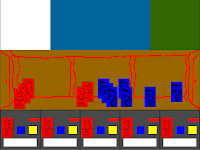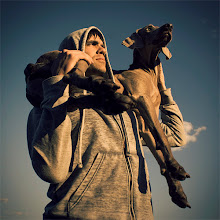Posted by:
Sam Horton on Jan 22, 2009 at 9:50 PM
One of my good friends, Chuck Wainman is joining the Funface Games team as a fellow game designer/developer. He taught me most of what I know about programming, and has a proclivity for turning 500 or so of my lines of code into two or three...Which is fine, because I usually have to convert his
programmer art into something that won't make your eyes bleed!
How it all began
Chuck and I have literally worked on thousands of small (student) games together while we taught a class called
Interactive Media Design at
Full Sail. Chuck is now teaching a class in software architecture, and brings a great deal of experience to the table, not just in programming, but in Game Design as well.
The challenges at hand
I've been running Funface Games solo for several years, but as of late, things have been getting too busy for one person to handle. There are several projects looming on the horizon, including a game that Chuck has been conjuring up for a while titled:
Hero Master. I'm definitely looking forward to being able to focus on specific tasks instead of spreading myself thin with the coding, art, sound design, promotion, yada yada yada. As fun as all of that is, you really can't exceed in everything at the same time.
So welcome aboard Chuck! Lets finish some games :)
Labels: Hero Master, news
By: Sam Horton | Jan 22, 2009 at 9:50 PM | | Leave a comment 

Posted by:
Unknown on at 7:41 PM
CONCEPTHero Master is the working title of the game. The idea is that the player is commanding a party of heroes. At the beginning, the player is only able to command a single hero, increasing to 4 or 5 during the game. The heroes begin with only a few skills. As the heroes gain experience, the player trains the heroes with new skills. This way, each hero can be unique as they specialize in different skills.
Heroes gain experience by exploring dungeons. A dungeon is made up of several rooms. The number of rooms in a dungeon increases as the game progresses. In each room, the heroes can have a variety of encounters. Most encounters are combat with monsters. Other encounters include skill tests of strength, intelligence, dexterity.
Outside of the dungeons, the player improves his heroes. This includes researching new skills, crafting equipment, purchasing new equipment, and recruiting new heroes. The player may have more heroes then the maximum allowed in a party. This heroes can be swapped into the party.
GAMEPLAYThe game starts in town with the player recruiting a hero from several available at the tavern. Then the player trains the hero with some basic skills and sends him into a training dungeon. The hero enters the first room and automatically engages the nearest monster. Each hero has a special attack that the player can activate. This special attack has recharge/
cooldown before it can be activated again. The heroes make their own targeting choices, not the player. If a HEAL is a special ability, then the hero will choose whom to heal--the hero with the least health.
LEVEL UPThe skills of a hero are auto-attack, special, weapon use, and armor use. Each of these can be improved with each new level. Auto-attack is the basic attack of the hero. Some stats that can be improved are: damage, recharge,
crit chance,
crit damage, range, area effect, stun, damage over time. Weapon and armor use allow the hero to wield different weapons and wear different armor.
PRESENTATION 
The main action of the dungeon fight is seen from the side, with the heroes starting on one side and the monsters on the other. The units, both heroes and monsters, move toward each other in the X axis. There is no up/down.
Below the dungeon view is information on the heroes. Each hero has a info area and a button to activate his special skill.
Above the dungeon view is map of the dungeon and game info area.
Labels: Concept, flash games, game design, Hero Master
By: Unknown | at 7:41 PM | | Leave a comment 

![]()
![]()



 Check out my Game Review Blog
Check out my Game Review Blog

